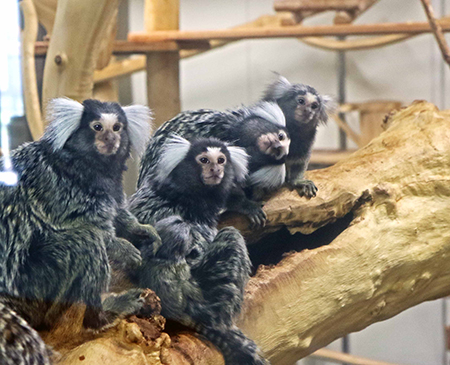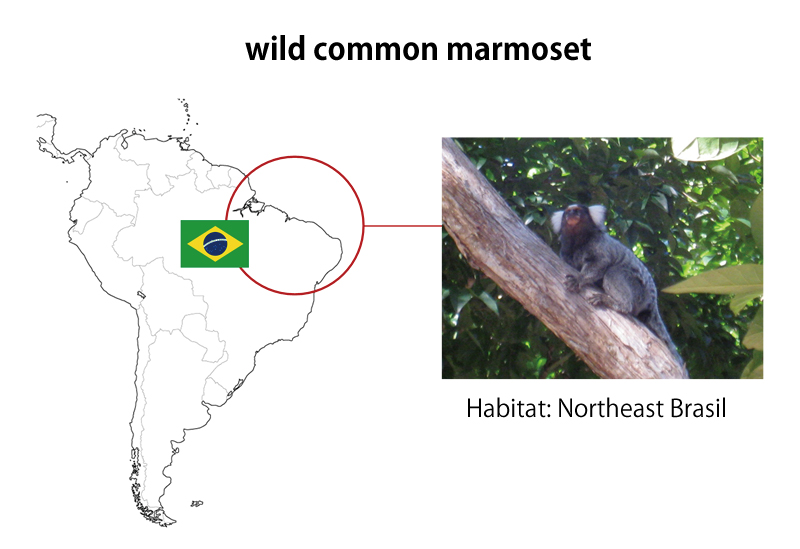
|
|
|
| English name |
common marmoset |
| Scientific name |
Callithrix jacchus
|
| Classification |
Primates, Haplorhini, Platyrrhini, Cebidae |
| Origin |
Northeastern Brazil |
| Body weight |
250-500 g (Adult), 25-40 g (at birth) |
| Body length |
20-25 cm Head and body length (excluding tail length) |
| Chromosome count |
2n = 46 |
| Life span |
12-15 years (more than 20 years in some cases) |
| Age of sexual maturation |
1.5 years |
| Gestation period |
145-148 days |
| Litter size |
1-3 offspring (4 offspring or more in some cases) |
What is the common marmoset?
The common marmoset, Callithrix jacchus (marmoset), is a small monkey species living in the tropical zone of the Atlantic coastal area of northeastern Brazil.
The marmoset is classified into Haplorhini (Anthropoidea), as with humans.
Haplorhini is further classified into Old World monkey (Catarrhini), which originated in Asia and Africa, and New World monkey (Platyrrhini), which originated in Latin America.
These two groups have different features as they have diverged and uniquely evolved from a common ancestor 30 to 40 million years ago.
The marmoset, a New World monkey, lives in family groups consisting of a pair of a male and a female and their offspring, and not only the mother, but also the father and older offspring nurse infants.
The marmoset shows behaviors not observed in other primates but similar to those of humans such as various vocal communication and sharing food, and is expected to be a model animal for social behavior research (Mansfield K. et al. Comp Med. 2003; Miller CT. et al. Neuron. 2016).
Marmosets contribute to biomedical research
The marmoset shares many features in anatomy, physiology and drug metabolism with humans, and contributes to biomedical research as a nonhuman primate model.
In addition, among nonhuman primates, the marmoset is small and easily handled, with many other advantages including high fertility, and is used for various medical researches as follows:
Drug discovery research
The thalidomide did not show any particular adverse reaction in the experiments using pregnant mice, but it was later revealed to cause serious malformations in humans if administered during early pregnancy.
Subsequently, it was reported that marmosets showed fetal malformations similar to those in humans (Poswillo DE. et al. Nature. 1972). It made the world aware of the usefulness of marmosets in drug discovery researches.
Research on neurological diseases
Marmosets are most frequently used in neuroscience. The animals have a developed brain unique to the primate, as well as high cognitive functions such as perception, memory, learning, thinking, and deciding, and is thus widely used as neurological disease models.
For example, as administration of MPTP, a dopamine neurotoxin, causes symptoms similar to Parkinson's disease, the Parkinson's disease models using marmosets have been used since the 1980s and are still used for the development of new remedies (Jenner P. et al. Neurosci Lett. 1984; Ando K. et al., Psychopharmacology. 2008).
Regenerative medicine research
For application of regenerative medicine using stem cells such as iPS cells to actual therapies, efficacy and safety should be evaluated by animal experiments.
At the early stage of the research, it may be technically and economically difficult to prepare a large number of cells to be transplanted, but with the marmoset which is similar to the rat in size, the analysis can be performed using a smaller number of cells.
For example, there are reports that the motor function of marmosets with spinal cord injuries was recovered after transplantation therapy using neural stem cells made from ES cells or iPS cells (Iwanami A. et al. Neurosci Res. 2005; Kobayashi Y. et al., PLoS One. 2012).
Because of the high fertility of the marmoset, the generation of genetically modified marmosets has been promoted (Sasaki E. et al. Nature. 2009; Sato K. et al. Cell Stem Cell. 2016).
Novel human diseases model marmosets based on genetically modification can contribute greatly to elucidating pathogenesis and discovering new therapeutic in intractable diseases.
- Marmoset models commonly used in biomedical research.
Mansfield K.
Comp Med. 2003 Aug;53(4):383-92.
- Marmosets: A Neuroscientific Model of Human Social Behavior.
Miller CT, Freiwald WA, Leopold DA, Mitchell JF, Silva AC, Wang X.
Neuron. 2016 Apr 20;90(2):219-33.
- 1-Methyl-4-phenyl-1,2,3,6-tetrahydropyridine-induced parkinsonism in the common marmoset.
Jenner P, Rupniak NM, Rose S, Kelly E, Kilpatrick G, Lees A, Marsden CD.
Neurosci Lett. 1984 Sep 7;50(1-3):85-90.
- Neurobehavioral protection by single dose l-deprenyl against MPTP-induced parkinsonism in common marmosets.
Ando K, Maeda J, Inaji M, Okauchi T, Obayashi S, Higuchi M, Suhara T, Tanioka Y.
Psychopharmacology (Berl). 2008 Jan;195(4):509-16.
- Transplantation of human neural stem cells for spinal cord injury in primates.
Iwanami A, Kaneko S, Nakamura M, Kanemura Y, Mori H, Kobayashi S, Yamasaki M, Momoshima S, Ishii H, Ando K, Tanioka Y, Tamaoki N, Nomura T, Toyama Y, Okano H.
J Neurosci Res. 2005 Apr 15;80(2):182-90.
- Transplantation of human neural stem cells for spinal cord injury in primates.
Iwanami A, Kaneko S, Nakamura M, Kanemura Y, Mori H, Kobayashi S, Yamasaki M, Momoshima S, Ishii H, Ando K, Tanioka Y, Tamaoki N, Nomura T, Toyama Y, Okano H.
J Neurosci Res. 2005 Apr 15;80(2):182-90.
- Pre-evaluated safe human iPSC-derived neural stem cells promote functional recovery after spinal cord injury in common marmoset without tumorigenicity.
Kobayashi Y, Okada Y, Itakura G, Iwai H, Nishimura S, Yasuda A, Nori S, Hikishima K, Konomi T, Fujiyoshi K, Tsuji O, Toyama Y, Yamanaka S, Nakamura M, Okano H.
PLoS One. 2012;7(12):e52787.
- The marmoset as an animal model for teratological research.
Poswillo DE, Hamilton WJ, Sopher D.
Nature. 1972 Oct 20;239(5373):460-2.
- Generation of transgenic non-human primates with germline transmission.
Sasaki E, Suemizu H, Shimada A, Hanazawa K, Oiwa R, Kamioka M, Tomioka I, Sotomaru Y, Hirakawa R, Eto T, Shiozawa S, Maeda T, Ito M, Ito R, Kito C, Yagihashi C, Kawai K, Miyoshi H, Tanioka Y, Tamaoki N, Habu S, Okano H, Nomura T.
Nature. 2009 May 28;459(7246):523-7.
- Generation of a Nonhuman Primate Model of Severe Combined Immunodeficiency Using Highly Efficient Genome Editing.
Sato K, Oiwa R, Kumita W, Henry R, Sakuma T, Ito R, Nozu R, Inoue T, Katano I, Sato K, Okahara N, Okahara J, Shimizu Y, Yamamoto M, Hanazawa K, Kawakami T, Kametani Y, Suzuki R, Takahashi T, Weinstein EJ, Yamamoto T, Sakakibara Y, Habu S, Hata J, Okano H, Sasaki E.
Cell Stem Cell. 2016 Jul 7;19(1):127-38.
History of marmoset research in CIEM
| 2010~ |
Published Laboratory Manual for marmoset studies -From handling to the frontline of research- (Sasaki et al. eds., 2018, Adthree) |
| Succeeded in the creation of immunodeficient marmosets using genome editing technology (Sato et al., 2016) |
Established Japan Society for Marmoset Research in cooperation with Japanese researchers
Moved the Institute to Tonomachi, a new facility for marmosets
|
| Established iPS cells (Tomioka et al., 2010) |
| 2000~ |
Succeeded in the creation and passage of transgenic marmosets (Sasaki et al., 2009) |
-
Established ES cells (Sasaki et al., 2005), fully started developmental engineering researches
-
Nonclinical model research for regenerative medicine, in cooperation with Keio University
-
Disease model research (e.g., spinal cord injury, Parkinson's disease, and myocardial infarction)
|
| Published Basic handbook of Marmoset handling (Tanioka ed., 1996, Adthree) |
| 1990~ |
Transferred the breeding colony to Japan E.D.M. Co., Ltd. (Currently CLEA Japan, Inc.) |
-
Researches on reproduction, experiment techniques, physiological and biochemical properties, etc.
-
Created germ-free marmosets (passage not achieved)
|
| Second introduction of marmosets from Imperial Chemical Industries (ICI) in the UK, established a breeding colony |
| 1980~ |
First introduction of marmosets from ICI, investigation of rearing and breeding procedures |
| Reviewed 12 types of small primate laboratory animals: "Establishment of small primate laboratory animals" |
Links
CLEA Japan Inc. (Background data etc.)
Japan Society for Marmoset Research (Japanese language only. Community of marmoset researchers in the medical science and life science fields)
Common Marmoset Care (About the ecology and rearing procedures of marmosets )
References
- Generation of a Nonhuman Primate Model of Severe Combined Immunodeficiency Using Highly Efficient Genome Editing.
Sato K, Oiwa R, Kumita W, Henry R, Sakuma T, Ito R, Nozu R, Inoue T, Katano I, Sato K, Okahara N, Okahara J, Shimizu Y, Yamamoto M, Hanazawa K, Kawakami T, Kametani Y, Suzuki R, Takahashi T, Weinstein EJ, Yamamoto T, Sakakibara Y, Habu S, Hata J, Okano H, Sasaki E.
Cell Stem Cell. 2016 Jul 7;19(1):127-38.
- Generation of transgenic marmosets expressing genetically encoded calcium indicators.
Park JE, Zhang XF, Choi SH, Okahara J, Sasaki E, Silva AC.
Sci Rep. 2016 Oct 11;6:34931.
- Generation of transgenic cynomolgus monkeys that express green fluorescent protein throughout the whole body.
Seita Y, Tsukiyama T, Iwatani C, Tsuchiya H, Matsushita J, Azami T, Okahara J, Nakamura S, Hayashi Y, Hitoshi S, Itoh Y, Imamura T, Nishimura M, Tooyama I, Miyoshi H, Saitou M, Ogasawara K, Sasaki E, Ema M.
Sci Rep. 2016 Apr 25;6:24868.
- Lineage-Specific Profiling Delineates the Emergence and Progression of Naive Pluripotency in Mammalian Embryogenesis.
Boroviak T, Loos R, Lombard P, Okahara J, Behr R, Sasaki E, Nichols J, Smith A, Bertone P.
Dev Cell. 2015 Nov 9;35(3):366-82.
- Prospects for genetically modified non-human primate models, including the common marmoset.
Sasaki E.
Neurosci Res. 2015 Apr;93:110-5.
- Pentatrichomonas hominis in laboratory-bred common marmosets.
Inoue T, Hayashimoto N, Yasuda M, Sasaki E, Itoh T.
Exp Anim. 2015;64(4):363-8.
- Resequencing of the common marmoset genome improves genome assemblies and gene-coding sequence analysis.
Sato K, Kuroki Y, Kumita W, Fujiyama A, Toyoda A, Kawai J, Iriki A, Sasaki E, Okano H, Sakakibara Y.
Sci Rep. 2015 Nov 20;5:16894.
- Birth of healthy offspring following ICSI in in vitro-matured common marmoset (Callithrix jacchus) oocytes.
Takahashi T, Hanazawa K, Inoue T, Sato K, Sedohara A, Okahara J, Suemizu H, Yagihashi C, Yamamoto M, Eto T, Konno Y, Okano H, Suematsu M, Sasaki E.
PLoS One. 2014 Apr 21;9(4):e95560.
- Birth of common marmoset (Callithrix jacchus) offspring derived from in vitro-matured oocytes in chemically defined medium.
Tomioka I, Takahashi T, Shimada A, Yoshioka K, Sasaki E.
Theriogenology. 2012 Oct 15;78(7):1487-93.
- Generating induced pluripotent stem cells from common marmoset (Callithrix jacchus) fetal liver cells using defined factors, including Lin28.
Tomioka I, Maeda T, Shimada H, Kawai K, Okada Y, Igarashi H, Oiwa R, Iwasaki T, Aoki M, Kimura T, Shiozawa S, Shinohara H, Suemizu H, Sasaki E, Okano H.
Genes Cells. 2010 Sep 1;15(9):959-69.
- Generation of transgenic non-human primates with germline transmission.
Sasaki E, Suemizu H, Shimada A, Hanazawa K, Oiwa R, Kamioka M, Tomioka I, Sotomaru Y, Hirakawa R, Eto T, Shiozawa S, Maeda T, Ito M, Ito R, Kito C, Yagihashi C, Kawai K, Miyoshi H, Tanioka Y, Tamaoki N, Habu S, Okano H, Nomura T.
Nature. 2009 May 28;459(7246):523-7.
- Preimplantation development of somatic cell cloned embryos in the common marmoset (Callithrix jacchus).
Sotomaru Y, Hirakawa R, Shimada A, Shiozawa S, Sugawara A, Oiwa R, Nobukiyo A, Okano H, Tamaoki N, Nomura T, Hiyama E, Sasaki E.
Cloning Stem Cells. 2009 Dec;11(4):575-83.
- Establishment of novel embryonic stem cell lines derived from the common marmoset (Callithrix jacchus).
Sasaki E, Hanazawa K, Kurita R, Akatsuka A, Yoshizaki T, Ishii H, Tanioka Y, Ohnishi Y, Suemizu H, Sugawara A, Tamaoki N, Izawa K, Nakazaki Y, Hamada H, Suemori H, Asano S, Nakatsuji N, Okano H, Tani K.
Stem Cells. 2005 Oct;23(9):1304-13.

